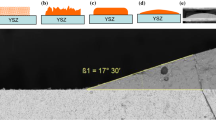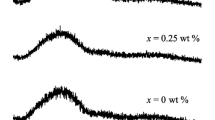Abstract
A family of sealant materials has been developed for use in the solid oxide fuel cell (SOFC) and in other applications in the temperature range of 800–1000 °C. These materials are based on glasses and glass-ceramics in the SrO–La2O3–Al2O3–B2O3–SiO2 system. The coefficients of thermal expansion (CTE) for these materials are in the range of 8–13 × 10−6/°C, a good match with those of the SOFC components. These sealant materials bond well with the ceramics of the SOFC and, more importantly, form bonds that can be thermally cycled without failure. At the fuel cell operating temperature, the sealants have viscosities in the range of 104–106 Pa-s, which allow them to tolerate a CTE mismatch of about 20% among the bonded substrates. The gas tightness of a sample seal was demonstrated in a simple zirconia-based oxygen concentration cell.
Similar content being viewed by others
References
H. Rawson, Properties and Applications of Glass, Glass Science and Technology, Vol. 3 (Elsevier, New York, 1980), pp. 74–82.
Y. Harufuji, Jpn. Kokai Tokkyo Koho JP 04-280,077 (Oct. 6th, 1992).
S. V. Phillips, A. K. Datta, and L. Lakin, Proc. 2nd Int. Symp. Solid Oxide Fuel Cells, July 2–5, 1991, Athens, Greece, pp. 737–745.
D. Stolten, E. Monreal, and W. Müller, Fuel Cell Seminar Abstracts, Nov. 29th–Dec. 2nd, 1992, Tucson, AZ, p. 253.
R. J. Späh, K. Zurell, and A. Koch, Fuel Cell Seminar Abstracts, Nov. 29th–Dec. 2nd, 1992, Tucson, AZ, p. 257.
I. Mukaisawa, Jpn. Kokai Tokkyo Koho JP 0660,891 (March 4, 1994).
Y. Harufuji, Jpn. Kokai Tokkyo Koho JP 04-47,672 (Feb. 17, 1992).
Y. Akiyama, N. Ishida, S. Murakami, and T. Saito, US Pat. No. 4,997,726 (March 5, 1991).
Materials for the Design Engineer: Properties of Corning’s Glass and Glass-ceramic Families, Sullivan Park Research & Development Laboratories of Corning Glassworks, p. 19.
M. B. Volf, Chemical Approach to Glass, Glass Science and Technology, Vol. 7 (Elsevier, New York, 1984), p. 132.
M. A. Matveev, G. M. Matveev, and B. N. Frenkel, Calculation and Control of Electrical, Optical, and Thermal Properties of Glass (Ordentlich, Holon, Israel, 1975), pp. 14–31.
J-H. Jean and T. K. Gupta, J. Mater. Res. 8, 356 (1993).
J-H. Jean and T. K. Gupta, J. Am. Ceram. Soc. 76, 2010 (1993).
Y. Ohta, M. Shimada, and M. Koizumi, J. Am. Ceram. Soc. 65, 572 (1982).
H. E. Hagy, J. Am. Ceram. Soc. 46, 93 (1963).
Z. Strnad, Glass-Ceramic Materials, Glass Science and Technology, Vol. 8 (Elsevier, New York, 1986), pp. 162–165.
W.H. Kohl, Handbook of Materials and Techniques for Vacuum Devices (Reinhold Publishing Co., New York, 1967), pp. 10–13.
Author information
Authors and Affiliations
Rights and permissions
About this article
Cite this article
Ley, K.L., Krumpelt, M., Kumar, R. et al. Glass-ceramic sealants for solid oxide fuel cells: Part I. Physical properties. Journal of Materials Research 11, 1489–1493 (1996). https://doi.org/10.1557/JMR.1996.0185
Received:
Accepted:
Published:
Issue Date:
DOI: https://doi.org/10.1557/JMR.1996.0185




